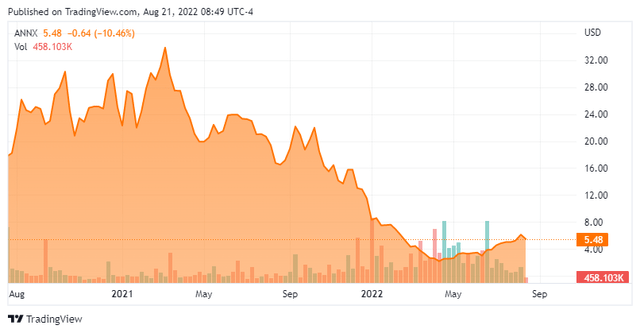gorodenkoff
Failure is the condiment that gives success its flavor.”― Truman Capote
Today, we take an in-depth look at a small biotech concern that had a recent setback but still has some ‘shots on goal‘. An analysis follows below.
Company Overview:
Annexon, Inc. (NASDAQ:ANNX) is a Brisbane, California based clinical-stage biopharmaceutical concern focused on the development of therapies that treat complement-mediated autoimmune, neurodegenerative, and ophthalmic disorders. The company has three clinical assets, all of which target the initiating molecule of the classical complement pathway: C1q. Annexon was formed in 2011 and went public in 2020, raising net proceeds of $262.4 million at $17 per share. The stock currently trades around $5.50 a share, translating to a market cap of approximately $360 million including recently issued warrants.
Complement System
For those unfamiliar, the complement system is part of the body’s immune system and is responsible for aiding in the elimination of microbes and damaged cells through three pathways: the classical complement; the alternative complement; and the lectin. Comprised of proteins produced by the liver, overactivation of the classical complement pathway can cause severe immune and inflammatory disorders. C1q is a protein complex that is part of the classical complement pathway and is activated when it binds specific antigen-antibody complexes. When overactivated, it triggers a powerful inflammatory cascade through the instigation of downstream pathway components that can cause tissue-damaging diseases. Annexon’s precision medicine platform is designed to produce C1q targeting compounds to block the early inflammatory cascade while preserving the beneficial immune functions of the lectin and alternative complement pathways critical to the clearance of pathogens and damaged cells.
Pipeline
From this platform Annexon has developed three clinical assets.
ANX005. The company’s lead candidate is ANX005, an intravenously administered monoclonal antibody designed to fully inhibit C1q throughout the body and across the blood brain barrier to combat autoimmune and neurodegenerative diseases. It is currently undergoing evaluation in four clinical trials, the most advanced of which is a Phase 2/3 clinical study for the treatment of Guillain-Barre Syndrome [GBS], a rare, acute, autoimmune disease damaging the peripheral nervous system of ~15,000 patients in North America and Europe with no approved therapies. The 180-patient, placebo-controlled trial is expected to readout in 2023 with primary endpoint change from baseline in GBS Disability Scale. In a completed Phase 1b study, ANX005 was well-tolerated and achieved C1q suppression in both the peripheral and central nervous systems.
However, ANX005’s Phase 2 study for Huntington’s disease [HD] has been the subject of significant concern after an interim readout in early January 2022 revealed that despite half of the 28 patients in the trial (at that time) experiencing clinical improvement in disease progression, five discontinued treatment, which somewhat contradicted the company’s assertion that ANX005 had been generally well-tolerated. Shares of ANNX fell 34% to $7.26 in the subsequent trading session, initiating a crash into the mid-2s.
A June 7th, 2022 data readout indicated that disease progression was stabilized in the overall HD population during both the six months of treatment and the three-month follow-up period. Nine of twelve patients with high complement levels demonstrated improvement at week 24 and maintained it through week 36. Furthermore, a biomarker for synapse loss remained generally consistent over the nine-month study period. Most importantly, no one else dropped from the study and the three patients determined to have developed treatment-related side effects had those events improve or resolve after discontinuation. All three cases were in patients with elevated antinuclear antibody (ANA) titers at baseline. No patient with normal ANA titers experienced a severe adverse event.
HD is a hereditary neurodegenerative disorder characterized by abnormal involuntary movements, progressive dementia, depression, and psychosis. In HD, C1q inappropriately tags synapses in the brain, sparking their destruction, inducing neurodegeneration. Onset of symptoms typically occurs between 30 to 50 years of age with death from cardio-respiratory complications approximately 10 to 20 years thereafter. Although there is medication to treat some of HD’s symptoms, there are no remedies that address its root cause for the ~30,000 Americans (80,000 globally) afflicted.
The early June readout somewhat validated Annexon’s precision medicine approach and triggered a 25% one-day rally to $4.06 a share. This news was later used to execute a private placement – more on that below.
ANX005 is also being studied in a Phase 2 trial for the treatment of warm autoimmune hemolytic anemia (AIHA), a malady characterized by the presence of auto-antibodies that bind to red blood cells. The temperature at which the binding occurs determines the warm or cold designation. Warm AIHA affects ~30,000 patients globally, with ~11% progressing to death. Data from the trial are anticipated in 2H22.
Finally, ANX005 is undergoing Phase 2 assessment in the treatment of amyotrophic lateral sclerosis (ALS), the infamous devastating neurodegenerative disease that afflicts ~30,000 patients worldwide. A readout from the study is expected in 2023.
The therapy has received Orphan Drug status from the FDA for GBS and HD as well as Fast Track designation for GBS.
ANX007. Annexon’s other asset in a Phase 2 trial is ANX007, a formulation of an antigen-binding fragment [FAB] that is designed to inhibit C1q locally in the eye (initially) for patients with geographic atrophy [GA]. Also known as atrophic age-related macular degeneration, GA affects more than 5 million worldwide and has no approved treatment options. Topline data for the intravitreally administered therapy is expected in 1H23.
ANX009. The company is also investigating ANX009, a subcutaneous formulation of a Fab designed to inhibit C1q only in the vascular space for the treatment of lupus nephritis. An ongoing Phase 1b trial is expected to produce initial data sometime in 2H22.
Balance Sheet & Analyst Commentary:
Management elected to leverage the somewhat positive news from the HD trial into a very dilutive capital raise, executing a private placement that raised gross proceeds of $130 million, consisting of common stock and pre-funded warrants representing 33.7 million shares at a price of ~$3.87, essentially doubling the total shares outstanding. Additionally, 8.4 million three-year common warrants with an exercise price of ~$5.81 were issued. This transaction, which closed on July 11, 2022, increased Annexon’s cash position to ~$300 million with no debt, providing it an operating runway into 2H25.
The Street is sanguine Annexon’s approach, featuring two buy and three outperform ratings. Since second quarter results posted earlier this month, four analyst firms including JPMorgan and Needham have reissued Buy ratings with price targets proffered in the $22 to $30 range.
Board member Muneer Satter used the private placement as an opportunity to add to his position, purchasing over 2.45 million shares, bringing his total to 4.41 million, representing a 6% ownership interest.
Verdict:
The market has reacted positively to the private placement, trading 10% higher from where the deal was priced. That rally has placed Annexon’s market cap ~10% above cash on its books. Although the HD trial discontinuations were unnerving, ANX005 has been (or is being) tested on 170 subjects across multiple trials and has been generally well-tolerated. The company plans to huddle with the FDA sometime in 2H22 to discuss next steps for ANX005 in the treatment of HD. During that same period, it will present Phase 2 data on ANX005 in the treatment of warm AIHA and Phase 1b results on ANX009 against lupus nephritis. 2023 will feature clinical readouts for GBS, ALS, and GA. Those catalysts represent multiple shots on goal for many indications that have no specifically approved therapy.
Although none of its completed trials have been powered for efficacy, it would appear that Annexon’s assets are poised to generate statistically significant clinical results in the upcoming data readouts. With its stock trading near cash, a would-be investor is receiving plenty of potential upside that makes Annexon investment worthy. Therefore, ANNX seems to merit a small ‘watch item‘ position at this point.
The mind once enlightened cannot again become dark.”― Thomas Paine



Be the first to comment